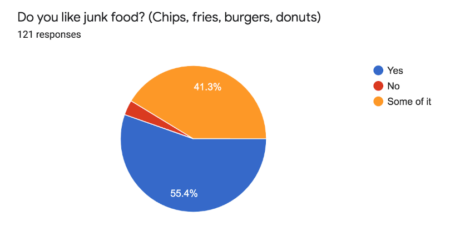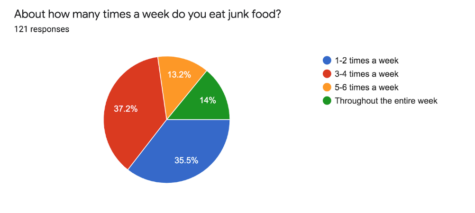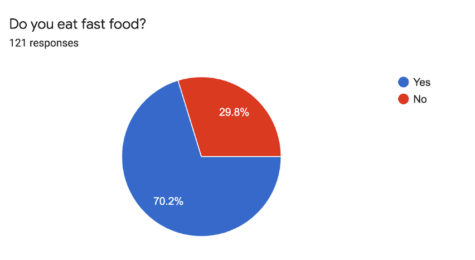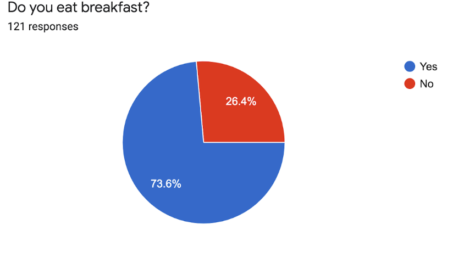What can too much junk food do to you?
November 8, 2019
An anonymous British teenager, who had been a “picky eater” ever since elementary school, lost most of his vision and part of his hearing due to his diet of junk food over the years. He had told doctors that since elementary school, his daily meals usually consisted of Pringles potato chips, white bread, processed ham, sausage and french fries from the local ‘Fish n Chip’ shop because he could not tolerate the texture of certain foods like fruits and vegetables.
He suffered from an eating disorder called AFRID (Avoidant Restrictive Food Intake Disorder). He became sensitive to taste, texture, smell and the appearance of certain types of food. This restricted his food intake to the extent where he did not meet his nutritional needs.
He first visited the doctor complaining about excessive fatigue at age 14. Blood tests confirmed he was deficient in iron and vitamin B12 and was treated with B12 shots and given dietary advice. At age 15, he had developed hearing loss. However, Magnetic Resonance Imaging (MRI) scans revealed nothing structurally abnormal. Shortly afterward, he started to encounter vision loss, but eye exams revealed nothing wrong, therefore, no diagnosis for his condition was identified.
Over the next two years, his vision had only gotten worse and had declined to a 20/200, which is considered legally blind in the United Kingdom and the United States. Further tests revealed that he was still low on B12, copper and Vitamin D. Additionally, his optic nerve was damaged. He was then diagnosed with nutritional optic neuropathy, a dysfunction of the optic nerve as a result of an improper diet that can be treatable if diagnosed early.
Parents, scientists and researchers worry that this rare medical disorder might become more prevalent in today’s society. The younger generations especially are at a higher risk of health issues due to lack of proper nutrient intake and all the excess amount of processed food that they are consuming. However, if students were to have a healthier lifestyle for a change they can positively affect their productivity inside and outside of school.
The extreme case was taken care of by doctors and scientists at the University of Bristol where the information gathered was then turned into a case report. Denize Atan, an ophthalmologist who was the lead author of the study, told The Washington Post, “Nutritional deficiencies are actually quite common, but nutritional blindness is not. Blindness is an uncommon but serious complication of poor nutrition.”
The risks of a poor diet are usually associated with obesity, different types of cancer, and poor function of the heart. However, Atan’s research shows that it can also have catastrophic effects on the immune system, which can sometimes be irreversible.
At Bristol Eye Hospital, Denize Atan said, “This case highlights the impact of diet on visual and physical health, and the fact that calorie intake and BMI (body mass index) are not reliable indicators of nutritional status.”
“It is important to eat a varied diet! There is not a single food that will provide all the vitamins and minerals you need — variety is the key,” said Atan. The 19-year old allowed the story to be covered by Annals of Internal Medicine to raise awareness about the impact of an unbalanced diet.
Eating junk food and fast food
Fast food is food that can be high in calories and low in nutritional value, for example mashed potatoes. Compared to fast food, junk food provides empty calories and supplies little to no protein, minerals or vitamins for a nutritious diet, like potato chips or a donut. Additionally, “Junk food is also usually high in added sugars, salt and saturated or trans fats.’Fast food’ is food that is prepared quickly and is eaten quickly or taken out.”
However, how healthy a meal is depends on how the meal is prepared and the ingredients used to make it. A taco is a meal that can be considered unhealthy for the most part, but if prepared right, this can be turned into a healthy meal.
Kentucky Fried Chicken, McDonald’s, Burger King and Taco Bell are all examples of places filled with foods high in calories with little dietary fiber, protein, vitamins or minerals. Eating junk food and fast food in moderation isn’t too unhealthy for the body. The recommended amount to have it is once or twice a week as a minimum, but having it more than three times a week is an excessive amount for the body. The maximum amount to keep the body at a healthier position should be to eat fast food or junk food about four to five times a month.
121 iSchool students recently completed a survey on fast food and students’ general dietary habits.
In response to the question, “Do you like junk food?” in terms of examples like chips and donuts, 55.4 percent said yes. Forty-one point three percent said that they only like a certain group of junk food and 3.3 percent said no.

‘Some of it’ and ‘yes’ were close in percentage. Only a small percent of these students said they didn’t like junk food. (This information was collected using Google Forms.)
In response to the following question, “About how many times a week do you eat junk food?”, 35.5 percent of the 121 students from the iSchool eat junk food one to two times a week. Thirty-seven point two percent eat it about three to four times a week, which combined is about 72 percent. The rest eat it 5-6 times a week or throughout the entire week, which combined is about 28 percent.

The information shows there was a close tie between students who eat junk food 1-2 times a week and students who eat junk food 3-4 times a week. However, not many students overeat junk food compared to the recommended amount. (This information was collected using Google Forms.)
The question following the previous one, “Do you eat fast food?” resulted in a variety of answers. This question was being asked in terms of eating food from fast food places like McDonald’s or Taco Bell. Seventy point two percent of the students who answered the question said that they do eat fast food and the other 29.8 percent said they do not.

The majority of the students do eat junk food and only about 30 percent of them do not. Compared to the data collected from the other survey questions it can be seen that some students may eat junk food, for example chips, but do not eat fast food. (This information was collected using google forms.)
The general diet of iSchool students is generally really mixed. However, the population is leaning more towards an unhealthy diet due to the amount of junk food and fast food students are consuming. Only 3 percent of students said that they do not eat junk food and about 30 percent of students do not eat fast food. That is less than half of the students who responded. In addition to eating junk food and fast food 63 percent of students eat it over the recommended amount. It can be concluded that the general diet of iSchool students is unbalanced.
Junk food and fast food were also found to have a correlation with different drinks according to the New Zealand Adolescent Frequency Food Questionnaire. Out of the students who answered the “factor analysis showed 24% correlation matrix of eating fast food while drinking fruit juice, 30% correlation with drinking tea or coffee, 37% correlation with milky drinks and 35% correlation with consumption of sugary drinks.”
Genesis Osorio, a sophomore at the iSchool, states, “junk food is cheap and good,” which is why students are more likely to eat it.
Anabelle Gonzalez, a senior at the iSchool also agrees. Even though she doesn’t eat it often, she believes it makes people and students want to buy it more, “I do generally think that because junk food is cheap more students would want to buy it. Like even if they might not exactly want to eat and might crave actual food they’re going to buy it because of the low price.”
“I believe eating junk food is fine in moderation,” states Michelle Leimseider, the assistant principal of the iSchool. Isora Bailey, the principal of the iSchool also agrees with her stating that food should be eaten in moderation.
Eating junk food in moderation will be more beneficial to the body to help prevent health disorders and help keep a more balanced diet instead.
Physical and mental health disorders
Many students and people in general aren’t aware of the effects that too much junk food can really cause on the body. It is viewed as an unhealthy food that can cause you to gain weight, but there is more to the impact of junk food than that.
Having an unbalanced diet can cause many short term and long term effects on the body. Short term effects of a poor diet include being overweight (which can also be a long term effect), higher stress levels, tiredness and reducing one’s capacity to work. As long term effects a poor diet can cause tooth decay, high blood pressure, high cholesterol, heart disease, proneness to strokes, type-2 diabetes, osteoporosis (weak and brittle bones), and different types of cancer.
A study conducted at Tufts University revealed that “poor diets cause about the same number of cancer cases as alcohol consumption does in the United States.” In actual numbers, “in 2015, poor diet was associated with over 52,200 colorectal cancer cases; over 14,400 mouth, pharynx and larynx cancers; nearly 3,200 uterine cancers; just over 3,000 cases of breast cancer in postmenopausal women; 2,000 kidney cancers; nearly 1,600 stomach cancers; and 1,000 liver cancers.”
Denize Atan also elaborates more on how specific nutritional deficiencies can indirectly affect you: “Dry eyes! Vitamin A deficiency causes extremely dry eyes which can lead to corneal ulceration and permanent scarring and visual impairment. Night blindness. Vitamin A deficiency also affects the function of the rods in the retina at the back of your eyes. Your rods are important for night vision so when they are not working properly, you have trouble seeing in the dark and develop tunnel vision. If prolonged, this sight loss can be permanent.”
“Optic neuropathy and central visual loss. Optic neuropathy can either cause central visual loss OR tunnel vision. When optic neuropathy is due to nutritional deficiencies, typically this affects central vision rather than peripheral vision (it is not clear why). The case we reported had optic neuropathy. This can be caused by deficiencies in thiamine, pyridoxine, niacin, folate, cobalamin, copper.”
A study that was led by Kelly M. Purtell at Ohio State University concluded that students who ate more fast food overall had a slower growth in academic achievement: “Students who reported eating fast food once a day had slower growth in math, reading and science than students who ate no fast food. The more fast food a student reported eating, the lower their rate of academic improvement.” It was found that the main cause of this impact was due to the fact that junk food does not have enough nutrient which doesn’t allow students to develop optimally.
An anonymous student from the iSchool revealed that when she eats junk food, she feels as if she “just wants to eat more right after which makes her [me] fall into a food coma” and feels unmotivated to do anything. Compared to when she eats a proper meal, she says, “I actually feel like I have energy, it makes me want to get up and do something. It just feels different, you know? Like you could tell and feel how different your body feels after eating too much junk food compared to when you eat a home cooked meal or something healthy.”
It is clear that mass consumption of junk food can affect people’s daily lives. Even though eating too much junk food can cause many health disorders, studies have shown that excessive amounts of junk food can also lead to mental disorders.
A study published by the International Journal of Food Sciences and Nutrition revealed that: “California adults who consumed more unhealthy food were also more likely to report symptoms of either moderate or severe psychological distress than their peers who consume a healthier diet.”
Jim E. Banta, PhD, MPH, associate professor at Loma Linda University School of Public Health and lead author of the study, connected this study to previous studies that have been conducted in other countries that have found a link between mental illness and an unhealthy diet as well. “Increased sugar consumption has been found to be associated with bipolar disorder, for example, and consumption of foods that have been fried or contain high amounts of sugar and processed grains have been linked with depression.”
The case report adds, “Perhaps the time has come for us to take a closer look at the role of diet in mental health, because it could be that healthy diet choices contribute to mental health. More research is needed before we can answer definitively, but the evidence seems to be pointing in that direction.”
It has been in question and currently put into research if having a healthier diet can help improve someone’s mental health. However, it is certain that consuming junk food and having an unhealthy diet can make people prone to mental health illnesses and physical disorders, which can affect people’s lives in general.
Students skipping breakfast
Students may be more likely to focus on the grumbling of their stomach rather than the lesson the teacher is presenting due to students not eating breakfast. Food is what the body uses as ‘fuel’ to keep it up and running. Without energy students cannot function properly, which is why starting the day off with a light, healthy meal is important for the body.
When you skip breakfast “the message your body gets is that it needs to conserve rather than burn any incoming calories.” Students who skip breakfast often are also more likely to be disruptive in school and may not have enough energy to get through the school day until they give their body energy. Sometimes students may not want to attend school at all due to the lack of energy they have.
Students will be more likely to get stomach-aches and headaches as well if they don’t eat breakfast. This is due to levels like your blood sugar going down. This can also happen if you skip any meal in general: “When you skip a meal or go a long time without eating, your body goes into survival mode,” states Haley Robinson, a Piedmont clinical dietitian. “This causes your cells and body to crave food which causes you to eat a lot. We usually tend to crave unhealthy foods and all attempts at eating healthy go out the door. When you are that hungry, anything goes.”
Collected from the survey previously mentioned, students were asked, “Do you eat breakfast?”. Only 73.6 percent of the 121 students do eat breakfast and 26.4 percent of them do not. The students who did eat breakfast were also asked to write what would they usual each for breakfast and the most common answer was cereal, eggs with bread and some type of cereal bar.

The majority of the students do eat breakfast and only about 26 percent of them do not. (This information was collected using google forms.)
Even though people have different preferences about eating breakfast, studies have shown that eating breakfast can provide many benefits for students.
Consuming a healthy meal in the morning gives students the ability to concentrate more in class and can improve memory. Different studies amongst children have shown that “kids who eat breakfast tend to have improved cognitive skills and perform better at school.”
Breakfast also has the ability to decrease student’s appetite throughout the day which can prevent students from eating excessive amounts of food and can reduce the chance of obesity. Breakfast can also lower the chances of getting a health disorder.
The Journal of the American College of Cardiology stated that people who never ate breakfast had an 87 percent higher risk of death from cardiovascular disease compared to those who ate breakfast every day.
The chance of getting type 2 diabetes can also be reduced by eating breakfast. Studies have found that the risk of getting diabetes has been reduced by 30% in people who regularly ate breakfast. “A possible explanation for this is that skipping breakfast can cause insulin resistance, which is a feature of Type 2 Diabetes.”
However, it is the content of the breakfast that plays a big role in the benefits it causes. It is recommended to have eggs, yogurt, oatmeal, fruits or a protein shake implemented in your breakfast. These foods provide energy, vitamins essential for the body and can also hold you off from eating any excess food until your next meal or snack.
There are many options for breakfast that can be easy to prepare to help students have a healthier, productive life.
School Lunch
The New York City Department of Education “offers free breakfast, lunch and afterschool meals to all NYC public school students during the school year.”
Michelle Leimseider states that she has never tried the school lunch since she came to the iSchool, but she thinks it’s amazing that lunch and breakfast is free for every kid.
School meals do have options, but can sometimes be limited in terms of some food groups and what meals they are giving. The NYC Department of School meals follows a calendar when it comes to deciding what meal will students be served each day, which are then followed by people who work in school cafeterias.
The department does try their best to provide healthy meals for students. Ms. Leimseider states, “They definitely try to encourage kids to have fruits and vegetables, but kids definitely pick and what they want to eat. There can be a salad you just don’t have to eat the salad. You can literally just take french fries if you wanted to.”
In terms of variety of the meals in general, guidance counselor Ms. Colon believes, “They don’t really equip the cafeterias [them] the way a restaurant kitchen does. I think that if there were more vegetable options a true salad bar that had different kinds of greens and protein that would have all those options, you’d be surprised about the healthier choices students would make.”
“I think that options are good due to food sensitivity,” states Ms. Bailey.
Students at the iSchool also believe there should be more options added for different diets, such as Israa, a freshman at the iSchool, who is a vegetarian. She states “I think they should add proper vegetarian meals for students like me because we don’t want to eat salad from the salad bar every day, we want vegetarian food that is actually appealing and is vegan or vegetarian.”
However, if there is a case where students can’t eat certain food options, the school meal department will try their best to take care of it: “We want to ensure that your child receives the best care possible while at school. We take allergies, food safety, and student health very seriously. We cannot guarantee a nut, milk or ‘allergen-free’ environment, but we do have an ‘allergen aware’ policy. Your child is less likely to be exposed to allergens at school when we work together to create a management plan for your child.”
There are many standards that the Department of School Lunch Meals have to follow. There are certain nutrient requirements and nutritional standards that every meal must have. Nicole Scarangello, the head of director of Menu Management for the Department of School meals states, “Designing the menu for schools can be a little hard sometimes because there are so many rules that we have to follow. We have the USDA requirements we have to follow and the nutritional standards we have to follow, then we have our own standards.”
At breakfast, schools must offer students all three required food components:
At lunch, schools must offer students all five required food components:
Standards per units CaloriesOur calorie requirements for meals align with the USDA’s weekly average nutrient requirements:
All snacks contain less than 200 calories, for all grades. SodiumAll meals contain a maximum of 480 mg per serving, and less for specified items, for all grades. All snacks contain less than 200 calories, for all grades. These standards are significantly higher than USDA’s requirements, which allows a maximum amount of sodium between 540-640 mg for breakfast—depending on your grade—and between 1,230-1,420 mg for lunch—again, depending on your grade. FatsOur standards for different fats mandate:
These standards meet or exceed the USDA requirements. SugarCereals may contain a maximum of 6 g sugar. FiberGrain items must contain 2 grams or more of fiber per serving. |
Students are allowed to go out and eat for lunch, and there are many places to go out to, however, walking distance and time can limit options on where to get lunch.
“This neighborhood is expensive and food is expressive and unfortunately the places that are not as expensive are places like McDonald’s, but there are also places like Trader Joe’s that have healthy snacks,” says Leimseider.
Ms. Colon adds, “it’s interesting. I don’t know if it’s because of what’s available and maybe fruit is a little cheaper.”
Joel Gonzalez, a freshman, believes, “Letting other students to go out for lunch increases the chance to get junk food, because deli’s, supermarkets, fast food restaurants are outside, [and] this can cause students to get junk food. However at the same time letting students go out for lunch let’s the students have a decision for themselves. As well there are places that offer high nutrition foods for students, which can be even healthier than school lunch.”
Going out for lunch can also give students the opportunity to get some exercise done by walking to places to get lunch.
“In other states everyone is driving everywhere. New York City kids walk a lot maybe they’re not exercising as much, and that’s a hard status [stat] to get, but as city folk we walk a lot” says Ms. Colon.
Studies have proven that exercise can be very beneficial to the body as well. It can help you feel happier, help with weight loss and increase your strength as well as energy levels. Exercise can also keep many health disorders away and help with brain health.
A good variety of food and good amounts of exercise is very essential to a healthy diet.
Making a change
The case of the anonymous British teenager serves as a cautionary tale of what can happen if too much junk food is consumed. Unfortunately, he had to give up the college courses he had been taking due to his loss of vision and hearing. In order to take care of him, his mother had to also give up her job.
However, he was able to bring a lot of awareness about the impact an unhealthy diet can cause and inspired many young kids, and even adults too, to change their diet to a healthier one.
You can make alternatives for junk food. Switch french fries or chips for sweet potato wedges or roasted vegetables.The next time you’re craving candy, try eating dried fruit or regular fruit. Whenever you want chocolate switch it for dark chocolate, it provides many beneficial effects like reducing your chance of getting heart disease! Exercising for good amounts a day can be good for the body. There can be many healthy decisions you can make to have a better diet and lifestyle.
Eating healthier can start out small even if it’s just eating fewer bags of chips a week or exercising for a little a few times a week. Healthier alternatives can also be used to replace junk food, and soon enough you can branch out to many different healthy meals to have a healthy, balanced diet.
Change your mindset, set attainable goals, then achieve them. It isn’t too late to make a change and switch to a healthier lifestyle.
